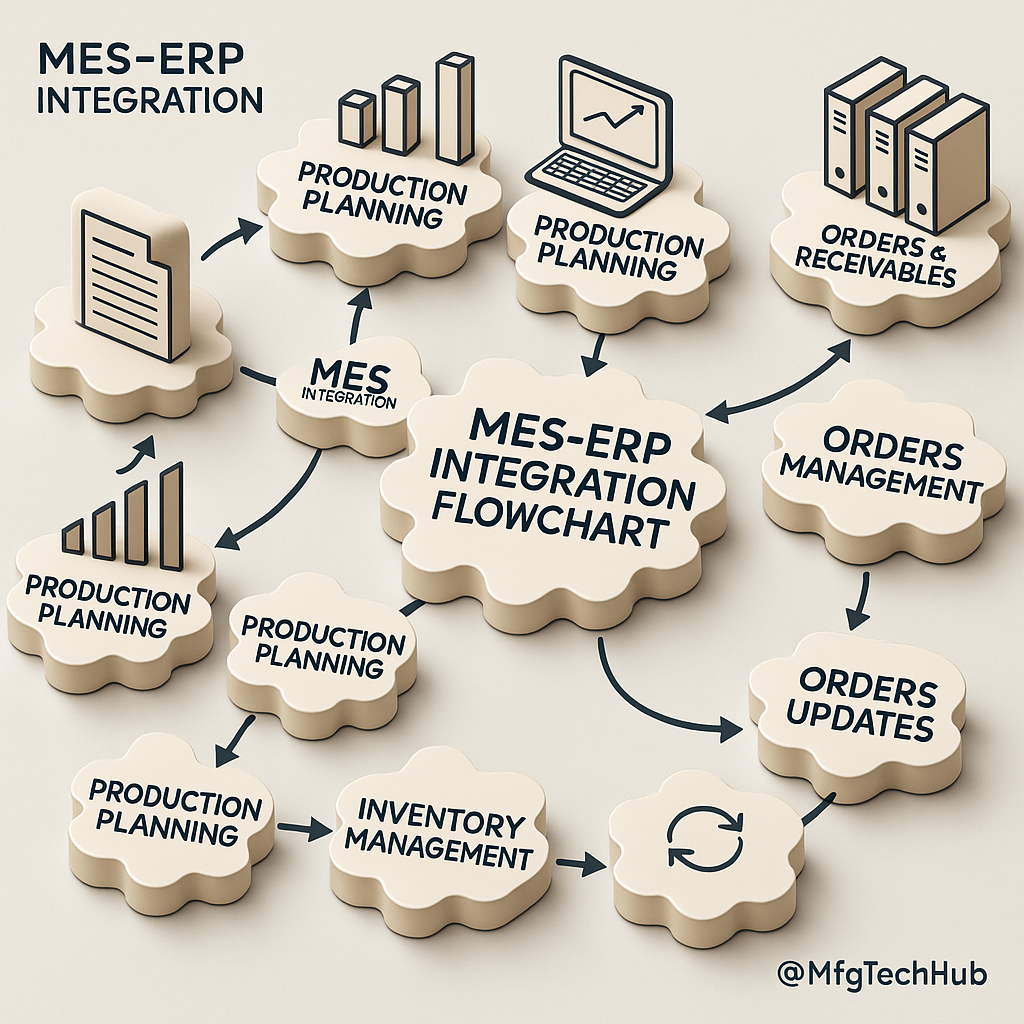How MES Works: ERP, SCADA, and PLC Integration
Why is Integration Important?
Manufacturing environments are complex, with multiple systems performing specific roles. Integration ensures that these systems work together cohesively, enabling:
- Data Synchronization: Real-time data sharing between shop floor and enterprise systems.
- Improved Decision-Making: Insights from MES inform decisions across all levels of operations.
- Operational Efficiency: Automation reduces manual intervention, ensuring faster and more accurate processes.
How MES Integrates with ERP, SCADA, and PLC
1. Integration with ERP Systems

ERP systems handle enterprise-level operations such as inventory management, supply chain, finance, and order processing. MES bridges the gap between ERP and the shop floor by:
- Sharing Real-Time Data: MES sends live production data to ERP for inventory updates and order tracking.
- Receiving Planning Data: MES uses production schedules, recipes, and resource plans from ERP to manage shop floor activities.
Example Integration Flow:
- An order is created in ERP → MES receives the order details → MES tracks production → MES sends completion data back to ERP for inventory adjustments.
2. Integration with SCADA Systems

SCADA systems focus on monitoring and controlling shop floor equipment. MES integrates with SCADA to:
- Collect Real-Time Data: MES gathers process parameters like temperature, pressure, and speed from SCADA.
- Control Operations: MES uses SCADA to adjust equipment settings based on production requirements.
Example Integration Flow:
- SCADA collects machine data → MES processes this data to monitor KPIs → MES sends commands to SCADA for operational adjustments.
3. Integration with PLCs

PLCs are hardware controllers that automate machine-level operations. MES connects with PLCs to:
- Execute Commands: MES sends instructions to PLCs for machine operations.
- Monitor Performance: PLCs provide MES with data on machine status, cycle times, and alarms.
Example Integration Flow:
- MES sends production parameters to PLC → PLC controls machine functions → PLC sends operational data back to MES for monitoring.
Technologies Enabling MES Integration

- Communication Protocols:
- OPC-UA: Facilitates data exchange between MES, SCADA, and PLCs.
- MQTT: Lightweight protocol for IoT device integration.
- REST APIs: Enable MES-ERP communication for data sharing.
- Middleware:
- Software solutions that connect disparate systems and handle data transformation.
- Example: Integrating MES with legacy ERP systems using middleware.
- IoT and Edge Computing:
- IoT devices collect real-time data from machines.
- Edge computing processes data locally before sending it to MES for further analysis.
Benefits of MES Integration

- End-to-End Visibility:
- Provides a holistic view of operations from raw materials to finished products.
- Enhanced Productivity:
- Reduces manual data entry and errors.
- Ensures real-time updates for faster decision-making.
- Improved Quality Control:
- Combines machine data (SCADA/PLC) with ERP insights to monitor and maintain quality.
- Cost Savings:
- Optimizes resource utilization by synchronizing production schedules with shop floor operations.
- Regulatory Compliance:
- Ensures traceability by integrating data from all levels of manufacturing.
Challenges in MES Integration
- System Compatibility:
- Older systems may not support modern integration protocols.
- Data Overload:
- Managing large volumes of real-time data requires robust infrastructure.
- High Implementation Costs:
- Integrating MES with ERP, SCADA, and PLC systems can be resource-intensive.
- Skill Gaps:
- Requires expertise in both IT and operational technologies.
Real-Life Example: MES Integration in Automotive Manufacturing
In an automotive assembly plant:
- ERP Integration: MES receives orders from ERP and updates inventory after production.
- SCADA Integration: MES monitors welding robots via SCADA for real-time quality checks.
- PLC Integration: MES sends assembly line instructions to PLCs, ensuring precise operations.
Outcome: The integration streamlines production, reduces downtime, and ensures timely delivery of vehicles.

Thank you for sharing a detailed explanation of how the process works or should work. I’m in production wiring and it’s far from the ideal process. We’re bogged down in rework in all phases and can’t see our way out. This will help tremendously. Thanks again.